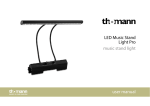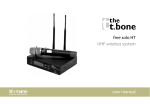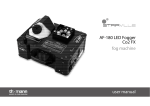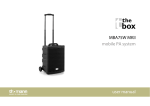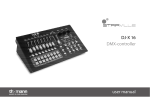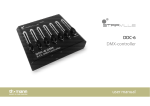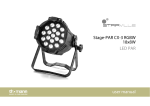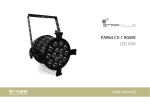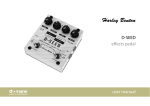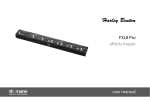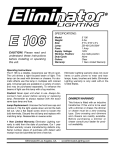Download LED Foot 8 DMX DMX-controller user manual
Transcript
LED Foot 8 DMX DMX-controller user manual Musikhaus Thomann Thomann GmbH Hans-Thomann-Straße 1 96138 Burgebrach Germany Telephone: +49 (0) 9546 9223-0 E-mail: [email protected] Internet: www.thomann.de 06.08.2015, ID: 332335 Table of contents Table of contents 1 General information................................................................................................................................. 1.1 Further information........................................................................................................................... 1.2 Notational conventions.................................................................................................................... 1.3 Symbols and signal words............................................................................................................... 5 6 7 9 2 Safety instructions.................................................................................................................................. 10 3 Features....................................................................................................................................................... 13 4 Starting up.................................................................................................................................................. 14 5 Connections and operating elements........................................................................................... 15 6 Basics............................................................................................................................................................. 25 7 Operating.................................................................................................................................................... 7.1 Channel assignment....................................................................................................................... 7.2 Scenes.................................................................................................................................................. 7.3 Chasers................................................................................................................................................. 7.4 Dimmer................................................................................................................................................ 7.5 Sound control, Auto mode........................................................................................................... 29 29 31 34 41 41 LED Foot 8 DMX 3 Table of contents 7.6 MIDI control........................................................................................................................................ 43 8 Technical specifications....................................................................................................................... 44 9 Plug and connection assignment.................................................................................................... 45 10 Protecting the environment.............................................................................................................. 47 DMX-controller 4 General information 1 General information This manual contains important instructions for the safe operation of the unit. Read and follow the safety instructions and all other instructions. Keep the manual for future reference. Make sure that it is available to all those using the device. If you sell the unit please make sure that the buyer also receives this manual. Our products are subject to a process of continuous development. Thus, they are subject to change. LED Foot 8 DMX 5 General information 1.1 Further information On our website (www.thomann.de) you will find lots of further information and details on the following points: Download This manual is also available as PDF file for you to download. Keyword search Use the search function in the electronic version to find the topics of interest for you quickly. Online guides Our online guides provide detailed information on technical basics and terms. Personal consultation For personal consultation please contact our technical hotline. Service If you have any problems with the device the customer service will gladly assist you. DMX-controller 6 General information 1.2 Notational conventions This manual uses the following notational conventions: Letterings The letterings for connectors and controls are marked by square brackets and italics. Examples: [VOLUME] control, [Mono] button. Displays Texts and values displayed on the device are marked by quotation marks and italics. Examples: ‘24ch’ , ‘OFF’ . LED Foot 8 DMX 7 General information Instructions The individual steps of an instruction are numbered consecutively. The result of a step is indented and highlighted by an arrow. Example: 1. Switch on the device. 2. Press [Auto]. ð Automatic operation is started. 3. Cross-references Switch off the device. References to other locations in this manual are identified by an arrow and the specified page number. In the electronic version of the manual, you can click the cross-reference to jump to the specified location. Example: See Ä ‘Cross-references’ on page 8. DMX-controller 8 General information 1.3 Symbols and signal words In this section you will find an overview of the meaning of symbols and signal words that are used in this manual. Signal word Meaning DANGER! This combination of symbol and signal word indicates an immediate dangerous situation that will result in death or serious injury if it is not avoided. NOTICE! This combination of symbol and signal word indicates a pos‐ sible dangerous situation that can result in material and environmental damage if it is not avoided. Warning signs Type of danger Warning – danger zone. LED Foot 8 DMX 9 Safety instructions 2 Safety instructions Intended use This device is used to control DMX-controlled LED spotlights. Use the device only as described in this user manual. Any other use or use under other operating conditions is considered to be improper and may result in personal injury or property damage. No liability will be assumed for damages resulting from improper use. This device may be used only by persons with sufficient physical, sensorial, and intellectual abilities and having corresponding knowledge and experience. Other persons may use this device only if they are supervised or instructed by a person who is responsible for their safety. Safety DANGER! Danger for children Ensure that plastic bags, packaging, etc. are disposed of properly and are not within reach of babies and young children. Choking hazard! Ensure that children do not detach any small parts (e.g. knobs or the like) from the unit. They could swallow the pieces and choke! Never let children unattended use electrical devices. DMX-controller 10 Safety instructions NOTICE! External power supply The device is powered by an external power supply. Before connecting the external power supply, ensure that the input voltage (AC outlet) matches the voltage rating of the device and that the AC outlet is protected by a residual cur‐ rent circuit breaker. Failure to do so could result in damage to the device and pos‐ sibly the user. Unplug the external power supply before electrical storms occur and when the device is unused for long periods of time to reduce the risk of electric shock or fire. NOTICE! Risk of fire Do not cover the device nor any ventilation slots. Do not place the device near any direct heat source. Keep the device away from naked flames. LED Foot 8 DMX 11 Safety instructions NOTICE! Operating conditions This device has been designed for indoor use only. To prevent damage, never expose the device to any liquid or moisture. Avoid direct sunlight, heavy dirt, and strong vibrations. DMX-controller 12 Features 3 Features Special features of the device: Controls up to 8 LED spotlights via DMX 16 scenes and 16 chasers programmable Quick setting of colour effects via rotary controls Operating modes: – manual – auto – sound-controlled n MIDI-capable n Floor device, all functions foot-controllable n Rugged design, ideal for stage use n n n n LED Foot 8 DMX 13 Starting up 4 Starting up Unpack and carefully check that there is no transportation damage before using the unit. Keep the equipment packaging. To fully protect the device against vibration, dust and moisture during transportation or storage use the original packaging or your own packaging material suitable for transport or storage, respectively. Establish all connections as long as the unit is switched off. Use the shortest possible highquality cables for all connections. Installing the device The device is designed for floor use. Position the unit on a flat, non-slip surface, use a non-slip pad if necessary. Connecting the PSU Connect the included 9V power supply unit to the power supply input of the unit and then plug the power cord plug into the wall outlet. Turning the unit on When all cable connections are made, turn on the device with the main switch on the rear panel. The display briefly shows ‘Load’ , the unit is instantly operational. DMX-controller 14 Connections and operating elements 5 Connections and operating elements Top view LED Foot 8 DMX 15 Connections and operating elements 1 Button group [Fixture] Buttons 1 to 8 to select the control channels. The corresponding indicator LED shows whether the respective channel is switched (LED on) or deactivated (LED off). 2 Operating panel See detailed view ‘Operating panel’ ( Ä ‘Operating panel’ on page 18). 3 Colour control See detailed view ‘Colour control’ ( Ä ‘Colour control’ on page 21). 4 [Music/Auto | Blackout] Foot switch to switch between the operating modes ‘Music’, ‘Auto’ and ‘Blackout’. 5 [Function | OFF] Foot switch to end the current scene or chaser. 6 [Down] Foot switch for switching to the next scene or chaser in the device memory. DMX-controller 16 Connections and operating elements 7 [Up] Foot switch for switching to the previous scene or chaser in the device memory. 8 [Scene Chase | Dimmer] Foot switch to switch between the operating modes ‘Scene’, ‘Chase’ and ‘Dimmer’. LED Foot 8 DMX 17 Connections and operating elements Operating panel 9 Display. 10 Button for programming scenes or chasers, increases the displayed value by one. DMX-controller 18 Connections and operating elements 11 Button for programming scenes or chasers, decreases the displayed value by one. 12 [Music] Indicator LED. This LED lights permanently in ‘Music’ mode. 13 [Auto] Indicator LED. This LED lights permanently in ‘Auto’ mode. 14 [Blackout] Indicator LED. This LED lights permanently in ‘Auto’ mode. 15 [Del] Button to delete programmed scenes, single steps or entire chases. 16 [Patch | Insert] Button to assign channels and to insert single steps into chasers. The corresponding indicator LED lights permanently once the mode is enabled. LED Foot 8 DMX 19 Connections and operating elements 17 [Mode] Button to switch between the operating modes ‘Scene’ and ‘Chase’ in programming mode. The corresponding indi‐ cator LED lights permanently once the mode is enabled. 18 [Program | Record] Button to switch to programming mode The corresponding indicator LED lights permanently once the mode is ena‐ bled. 19 [Dimmer] Indicator LED. This LED lights permanently in ‘Dimmer’ mode. 20 [Chase] Indicator LED. This LED lights permanently in ‘Chase’ mode and during chaser programming. 21 [Scene] Indicator LED. This LED lights permanently in ‘Scene’ mode and during scene programming. DMX-controller 20 Connections and operating elements Colour control 22 [White] Rotary control to adjust the brightness ‘white’. 23 [Red] Rotary control to adjust the brightness ‘red’. LED Foot 8 DMX 21 Connections and operating elements 24 [Dimmer] Rotary control to adjust the dimmer. 25 [Green] Rotary control to adjust the brightness ‘green’. 26 [User Definable] Rotary control to adjust a user definable function (e.g. Shutter, Stroboscope,…). 27 [Blue] Rotary control to adjust the brightness ‘blue’. 28 [User Definable] Rotary control to adjust a user definable function (e.g. Shutter, Stroboscope,…). 29 [Amber] Rotary control to adjust the brightness ‘amber’. DMX-controller 22 Connections and operating elements Rear panel 30 [MIDI] MIDI input. 31 [AUDIO] RCA input for connecting audio equipment for sound control. 32 [DMX OUT] Lockable DMX output socket. LED Foot 8 DMX 23 Connections and operating elements 33 Connection socket for the supplied 9 V power supply unit. 34 [OFF | ON] Main switch to turn the device on and off. DMX-controller 24 Basics 6 Basics This chapter contains basic information about data transmission via DMX protocol. Signal transmission DMX signals are generated by a DMX controller and transmitted to the connected devices using a DMX cable. Up to 512 channels per connection can be transmitted, with a value between 0 and 255 is transmitted for each channel. The 512 channels form a so-called ‘DMX universe’. Wiring DMX devices are wired in series, i.e., a transmitting unit sends out signals to all connected receivers. The receiver arrangement in the device chain can be chosen arbitrarily, since all devices filter and process the relevant data independently. To form a serial device chain, the DMX input of the first receiver is to be connected to the DMX output of the controller or other DMX master unit. The output of the first receiver then has to be connected to the input of the second and so on. The output of the last receiver in a DMX chain must be terminated with a resistor (110 Ω, ¼ W). LED Foot 8 DMX 25 Basics From a cable length of more than 300 m or after 32 connected DMX devices, the signal must be strengthened by a DMX booster. DMX-controller 26 Basics Signal conversion Every DMX device operates with a certain vendor specific number of channels through which the incoming control signals are converted into movements, brightness or colour changes, etc.. Since all receivers in a DMX chain always receive all signals, a starting address must be assigned to each DMX device. Starting from this address (a value between 1 and 512), the incoming signals are then interpreted by the receiver and implemented in accordance with the function mode set on the receiver (device-internal channel assignment). Within a DMX chain, one start address can easily be assigned multiply. The corresponding receivers then operate synchronously (same movements, same brightness, same colour, etc.). Addressing When assigning DMX addresses, it's critical how the device counts. Depending on the design, counting of channels starts at 0 or 1. Fixture DMX channels 1 1…8 2 9…16 3 17…24 4 25…32 LED Foot 8 DMX 27 Basics Fixture DMX channels 5 33…40 6 41…48 7 49…56 8 57…64 DMX-controller 28 Operating 7 Operating 7.1 Channel assignment Proceed as follows to assign DMX channels: 1. Keep the [Program | Record] button pressed for three seconds. ð The indicator LED [Program | Record] lights up. 2. Press [Mode]. ð The indicator LED [Mode] lights up. 3. Keep the [Patch | Insert] button pressed for three seconds. ð The indicator LED [Patch | Insert] lights up. The device is now in ‘Channel Patch’ mode. 4. Use the [Fixture] buttons 1 to 8 to activate a control channel. ð The indicator LED of the activated control channel lights. 5. Use the rotary controls [White], [Red], [Green], [Blue] and [Amber] to select a channel func‐ tion. LED Foot 8 DMX 29 Operating 6. Use the buttons and to adapt the DMX channel assignment. If the indicator value flashes this address on the control channel is already in use. Select a different address or reassign the occupied address as well. 7. Repeat steps 4 to 6 in order to adjust the assignment of the other control channels. 8. Briefly press the [Program | Record] button to save the changes. ð All indicator LEDs flash three times briefly when the new settings are saved. DMX-controller 30 Operating 7.2 Scenes Saving scenes 1. Keep the [Program | Record] button pressed for three seconds to change to program‐ ming mode. ð The indicator LED [Program | Record] lights up. 2. Use [Fixture] buttons 1 to 8 to activate the devices to be integrated into the scene. ð The indicator LEDs of the activated control channels light. 3. Use the rotary controls [White], [Red], [Green], [Blue] and [Amber] to adjust the colour set‐ tings and the two user definable controls to adjust the assigned functions. 4. Use the buttons and to select a memory slot ( ‘Sc.01’ … ‘Sc.16’ ). If the indicator value flashes this memory slot is already in use. Assign a different memory slot or overwrite the existing settings. 5. Press the [Program | Record] button to save the scene. ð All indicator LEDs flash three times briefly when the new scene has been saved. 6. Repeat steps 2 to 5 to save additional scenes. A maximum of 16 scenes can be saved in the device. LED Foot 8 DMX 31 Operating 7. Keep the [Program | Record] button pressed for three seconds to quit the programming mode. ð The indicator LED [Program | Record] turns off. Deleting scenes 1. Keep the [Program | Record] button pressed for three seconds to change to program‐ ming mode. ð The indicator LED [Program | Record] lights up. 2. Use the buttons 01’ … ‘Sc.16’ ). 3. Press the [Del] button to delete the scene. and to select the scene to be deleted from the device memory ( ‘Sc. ð All indicator LEDs flash three times briefly when the scene has been deleted. 4. Repeat steps 2 and 3 to delete further scenes. 5. Keep the [Program | Record] button pressed for three seconds to quit the programming mode. ð The indicator LED [Program | Record] turns off. DMX-controller 32 Operating Calling scenes 1. Press foot switch [Scene Chase | Dimmer] until the indicator LED [Scene] lights up. 2. Use foot switches [Up] and [Down] to select one of the saved scenes ‘Sc.01’ … ‘Sc.16’ . 3. Briefly press foot switch [Function | OFF] to end a running scene. Keep foot switch [Music/Auto | Blackout] pressed to blackout all connected LED lights. LED Foot 8 DMX 33 Operating 7.3 Chasers Saving chasers 1. Keep the [Program | Record] button pressed for three seconds to change to program‐ ming mode. ð The indicator LED [Program | Record] lights up. 2. Press [Mode]. ð The indicator LEDs [Mode] and [Chase] light up. 3. Use [Fixture] buttons 1 to 8 to activate the devices to be integrated into the chaser. ð The indicator LEDs of the activated control channels light. 4. Use the rotary controls [White], [Red], [Green], [Blue] and [Amber] to adjust the colour set‐ tings and the two user definable controls to adjust the assigned functions. 5. Use the buttons and to select a memory slot ( ‘CS.01’ … ‘CS.16’ ). If the indicator value flashes this memory slot is already in use. Assign a different memory slot or overwrite the existing settings. 6. Press the [Program | Record] button to save the chaser. ð All indicator LEDs flash three times briefly when the new chaser has been saved. DMX-controller 34 Operating 7. Repeat steps 3 to 6 to save additional chasers. A maximum of 16 chasers can be saved in the device. Each chaser can consist of a max‐ imum of 99 steps. 8. Keep the [Program | Record] button pressed for three seconds to quit the programming mode. ð The indicator LED [Program | Record] turns off. LED Foot 8 DMX 35 Operating Inserting steps into chasers 1. Keep the [Program | Record] button pressed for three seconds to change to program‐ ming mode. ð The indicator LED [Program | Record] lights up. 2. Press [Mode]. ð The indicator LEDs [Mode] and [Chase] light up. 3. Use the buttons 16’ ). 4. Press [Patch | Insert]. and to select the chaser you want to add a step to ( ‘CS.01’ … ‘CS. ð The indicator LED [Patch | Insert] flashes. 5. Use the buttons and to select a memory slot ( ‘sT01’ … ‘sT99’ ). If the indicator value flashes this memory slot is already in use. Assign a different memory slot or overwrite the existing settings. 6. Use [Fixture] buttons 1 to 8 to activate the devices to be integrated into the single step. ð The indicator LEDs of the activated control channels light. 7. Use the rotary controls [White], [Red], [Green], [Blue] and [Amber] to adjust the colour set‐ tings and the two user definable controls to adjust the assigned functions. DMX-controller 36 Operating 8. Press the [Program | Record] button to save the step. ð All indicator LEDs flash three times briefly when the new step has been saved. 9. Repeat steps 4 to 8 to insert additional steps (maximal 99). 10. Keep the [Program | Record] button pressed for three seconds to quit the programming mode. ð The indicator LED [Program | Record] turns off. LED Foot 8 DMX 37 Operating Deleting steps from a chaser 1. Keep the [Program | Record] button pressed for three seconds to change to program‐ ming mode. ð The indicator LED [Program | Record] lights up. 2. Press [Mode]. ð The indicator LEDs [Mode] and [Chase] light up. 3. Use the buttons ‘CS.16’ ). 4. Press [Patch | Insert]. and to select the chaser you want to delete a step from ( ‘CS.01’ … ð The indicator LED [Patch | Insert] flashes. 5. Use the buttons 6. Press the [Del] button to delete the step. and to select the desired step ( ‘sT01’ … ‘sT99’ ). ð All indicator LEDs flash three times briefly when the step has been deleted. 7. Repeat steps 4 and 6 to delete further steps. 8. Keep the [Program | Record] button pressed for three seconds to quit the programming mode. DMX-controller 38 Operating ð The indicator LED [Program | Record] turns off. Deleting chasers 1. Keep the [Program | Record] button pressed for three seconds to change to program‐ ming mode. ð The indicator LED [Program | Record] lights up. 2. Use the buttons and ( ‘SC.01’ … ‘Sc.16’ ). 3. Keep the [Del] button pressed for three seconds to delete the chaser. to select the chaser to be deleted from the device memory ð All indicator LEDs flash three times briefly when the chaser has been deleted. 4. Repeat steps 2 and 3 to delete further chasers. 5. Keep the [Program | Record] button pressed for three seconds to quit the programming mode. ð The indicator LED [Program | Record] turns off. LED Foot 8 DMX 39 Operating Calling chasers 1. Press foot switch [Scene Chase | Dimmer] until the indicator LED [Chase] lights up. 2. Use foot switches [Up] and [Down] to select one of the saved chasers ‘CS.01’ … ‘CS.16’ . Use [Music/Auto | Blackout] to change between operating modes ‘Music’ and ‘Auto’ in order to adjust the settings: Activate the ‘Music’ mode (LED [Music] lights up), press foot switch [Function | OFF] and use foot switches [Up] and [Down] to adjust the sound control sensitivity in a range from ‘S000’ … ‘S100’ . The value is applied as soon as the display skips back. Activate the ‘Auto’ mode (LED [Auto] lights up), press foot switch [Function | OFF] and use foot switches [Up] and [Down] to adjust the progress speed for Auto mode in a range from ‘SP.01’ … ‘Sp.12’ . The value is applied as soon as the display skips back. 3. Briefly press foot switch [Function | OFF] to end a running chaser. Keep foot switch [Music/Auto | Blackout] pressed to blackout all connected LED lights. DMX-controller 40 Operating 7.4 Dimmer 1. Keep foot switch [Scene Chase | Dimmer] pressed for about two seconds to change to Dimmer mode. ð The indicator LED [Dimmer] lights up. 2. Adjust the dimmer using foot switches [Up] and [Down] in a range from ‘dI.00’ … ‘dI.FL’ . A single keystroke changes the setting by factor 1 up or down. Keep the foot switch pressed to adjust the Dimmer setting up or down quickly. 3. Press foot switch [Scene Chase | Dimmer] briefly to change to ‘Chase’ mode. 7.5 Sound control, Auto mode In Chase mode, you can change between Sound control and Auto mode: LED Foot 8 DMX 41 Operating 1. Press foot switch [Scene Chase | Dimmer] until the indicator LED [Chase] lights up. 2. Use foot switch [Music/Auto | Blackout] to change between operating modes ‘Music’ and ‘Auto’. Activate the ‘Music’ mode (LED [Music] lights up), press foot switch [Function | OFF] and use foot switches [Up] and [Down] to adjust the sound control sensitivity in a range from ‘S000’ … ‘S100’ . The value is applied as soon as the display skips back. Activate the ‘Auto’ mode (LED [Auto] lights up), press foot switch [Function | OFF] and use foot switches [Up] and [Down] to adjust the progress speed for Auto mode in a range from ‘SP.01’ … ‘Sp.12’ . The value is applied as soon as the display skips back. If you keep the foot switch pressed for about two seconds the unit changes to ‘Blackout’ mode and blackouts all connected LED spotlights. ð The indicator LED of the activated operating mode lights. 3. Press foot switch [Scene Chase | Dimmer] briefly to change to ‘Chase’ mode. DMX-controller 42 Operating 7.6 MIDI control MIDI mapping, channel 1 MIDI command MIDI note Function Scene num 01…16 0x00 0x7f Chase num 17…32 0x00 0x7f Chase mode 33 0x00 0x01 Music Sensitivity 34 0x00 0x64 Chase Speed 35 0x00 0x0c Chase Fade 36 0x00 0x64 Dimmer 37 0x00 0x64 Blackout 126 0x00 0x01 LED Foot 8 DMX 43 Technical specifications 8 Technical specifications Operating voltage supply 9V Dimensions (W × D × H) 375 mm× 188 mm× 88 mm Weight 1.8 kg (DC) DMX-controller 44 Plug and connection assignment 9 Plug and connection assignment Introduction This chapter will help you select the right cables and plugs to connect your valuable equip‐ ment so that a perfect light experience is guaranteed. Please take our tips, because especially in ‘Sound & Light’ caution is indicated: Even if a plug fits into a socket, the result of an incorrect connection may be a destroyed DMX controller, a short circuit or ‘just’ a not working light show! DMX connections The unit offers a 3-pin XLR socket for DMX output and a 3-pin XLR plug for DMX input. Please refer to the drawing and table below for the pin assignment of a suitable XLR plug. Pin Configuration 1 Ground, shielding 2 Signal inverted (DMX–, ‘cold signal’) 3 Signal (DMX+, ‘hot signal’) LED Foot 8 DMX 45 Plug and connection assignment RCA connection Drawing and table indicate the pin assignment of an RCA plug. 1 Signal 2 Ground, shielding DMX-controller 46 Protecting the environment 10 Protecting the environment Disposal of the packaging mate‐ rial For the transport and protective packaging, environmentally friendly materials have been chosen that can be supplied to normal recycling. Ensure that plastic bags, packaging, etc. are properly disposed of. Do not just dispose of these materials with your normal household waste, but make sure that they are collected for recycling. Please follow the notes and markings on the packaging. Disposal of your old device This product is subject to the European Waste Electrical and Electronic Equipment Directive (WEEE). Do not dispose with your normal household waste. Dispose of this device through an approved waste disposal firm or through your local waste facility. When discarding the device, comply with the rules and regulations that apply in your country. If in doubt, consult your local waste disposal facility. LED Foot 8 DMX 47 Notes DMX-controller 48 Notes LED Foot 8 DMX 49 Notes DMX-controller 50 Musikhaus Thomann · Hans-Thomann-Straße 1 · 96138 Burgebrach · Germany · www.thomann.de




















































